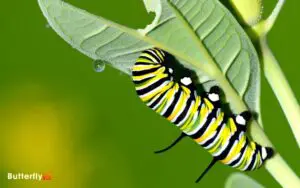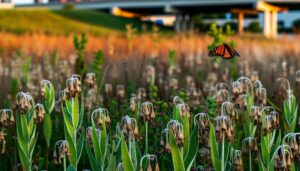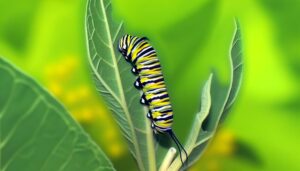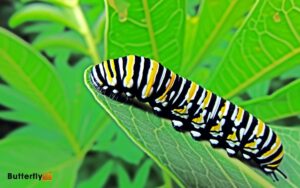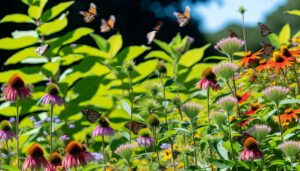Monarch Butterflies in North Carolina: Explore the Routes!
In North Carolina, monarch butterflies begin an amazing lifecycle, starting as eggs laid on milkweed plants.
The larvae, or caterpillars, consume milkweed leaves voraciously before forming a chrysalis and transforming into butterflies over 10-14 days. These butterflies undertake an incredible migration, traveling up to 100 miles a day.
Waystations with nectar-rich flowers provide essential rest stops. However, threats like habitat loss, climate change, and pesticides jeopardize their populations.
Local conservation efforts include planting projects and educational programs to restore native milkweed habitats. You’re about to discover more about how to help support these incredible insects.

Key Takeaways
Monarch Butterfly Lifecycle
The monarch butterfly lifecycle consists of four distinct stages: egg, larva (caterpillar), pupa (chrysalis), and adult butterfly.
You’ll find the eggs laid on milkweed plants, where they hatch into larvae. These caterpillars, identifiable by their black, white, and yellow stripes, undergo five growth phases called instars. During this period, they voraciously consume milkweed leaves, storing energy for the next stage.
After two weeks, the caterpillar forms a chrysalis, entering the pupa stage. Here, metamorphosis occurs over 10-14 days, transforming the caterpillar into an adult butterfly.
Migration Journey
Each year, millions of monarch butterflies commence on an extraordinary migration journey spanning thousands of miles from North America to their overwintering sites in central Mexico.
You’ll find that these butterflies rely on environmental cues like temperature changes and daylight length to begin their journey. They navigate using a combination of the sun’s position, magnetic fields, and possibly even polarized light.
Monarchs travel up to 100 miles a day, resting at night in clusters to conserve energy. During this migration, they face challenges such as predators, adverse weather, and habitat loss.
Understanding their precise route and behavior is essential for conservation efforts, ensuring these delicate travelers continue their remarkable journey year after year.
North Carolina Waystations
As monarch butterflies navigate their arduous migration journey, North Carolina waystations play an essential role in providing essential rest stops and resources.
You’ll find these waystations strategically located to offer nectar-rich flowers for feeding and sheltered spots for rest.
Each waystation is designed to mimic natural habitats, ensuring monarchs can refuel and continue their long trek. Key features include diverse native plant species, such as asters and goldenrods, which bloom at critical times during the migration.
By incorporating these elements, waystations become important refuges, supporting not only monarchs but also other pollinators.
When you visit these waystations, you’re witnessing a meticulously planned effort to sustain monarch populations through their challenging journey.
Importance of Milkweed
You can’t overstate the importance of milkweed for monarch butterflies in North Carolina. This plant serves as the essential habitat for monarchs, providing the only food source for their larvae.
With various milkweed species like common milkweed and swamp milkweed, you can create a supportive environment for these butterflies.
Essential Monarch Habitat
Milkweed serves as the primary host plant for monarch butterflies, providing essential nutrients and a site for egg-laying critical for their life cycle.
Without milkweed, monarchs can’t survive. You’ll find that milkweed’s unique properties offer monarch caterpillars the specific toxins they need for defense against predators.
These toxins, called cardenolides, accumulate in the caterpillar’s body, making them distasteful to potential threats. Additionally, the vibrant flowers of milkweed attract adult monarchs, offering nectar and a suitable environment for reproduction.
| Emotion | Description |
|---|---|
| Hope | Seeing milkweed thrive can give you hope for the monarch’s future. |
| Responsibility | Understanding the importance of milkweed makes you feel responsible for it. |
| Urgency | Realizing the scarcity of milkweed creates a sense of urgency in you. |
Milkweed Plant Varieties
Understanding the different varieties of milkweed is crucial for supporting monarch populations, as each species offers unique benefits and grows in specific habitats across North Carolina.
You’ll find that each milkweed species supports monarchs uniquely. For instance,
- Common Milkweed (Asclepias syriaca): Grows in sunny, disturbed areas.
- Swamp Milkweed (Asclepias incarnata): Prefers wet, marshy conditions.
- Butterfly Weed (Asclepias tuberosa): Drought-tolerant, vibrant blooms.
Threats to Monarchs
Monarch butterflies in North Carolina face significant threats from habitat loss, climate change, and pesticide use. Urban development encroaches on their breeding grounds, reducing milkweed availability essential for larvae.
Climate change alters migratory patterns, affects breeding cycles, and increases the frequency of extreme weather events, challenging their survival.
Additionally, widespread use of pesticides, particularly neonicotinoids, impacts both adult butterflies and larvae by contaminating nectar sources and milkweed plants. These chemicals can disrupt their nervous systems, leading to disorientation and death.
Furthermore, herbicides used in agricultural fields eliminate milkweed, further depleting essential habitat. Understanding these threats is crucial to develop strategies that mitigate their impact and support the monarch population in North Carolina.
Local Conservation Efforts
In response to the declining monarch population, North Carolina has implemented targeted conservation initiatives to restore habitats and promote native milkweed growth. These efforts are vital for supporting the monarchs’ lifecycle and migration patterns.
The state has introduced several key programs:
- Pollinator-friendly planting projects: These involve cultivating native plants, like milkweed, which are essential for monarch breeding and feeding.
- Educational outreach initiatives: Workshops and seminars are conducted to inform the public about the importance of monarch conservation and how to create butterfly-friendly environments.
- Collaborative partnerships: Local governments, environmental organizations, and schools work together to establish and maintain monarch habitats.
How to Help
You can contribute to monarch butterfly conservation by planting native milkweed species and other nectar-rich flowers in your garden or community spaces. Milkweed serves as the primary host plant for monarch caterpillars, providing essential nutrients for their growth.
Choose species like Asclepias tuberosa (Butterfly Weed) or Asclepias incarnata (Swamp Milkweed) that thrive in North Carolina. Additionally, plant nectar-rich flowers such as Liatris, Echinacea, and Solidago to support adult butterflies.
Avoid using pesticides, as they can harm monarchs and other pollinators. Create a diverse habitat by incorporating a variety of plant species to guarantee year-round food sources.
Conclusion
You’ve learned about the monarchs’ lifecycle, their epic migration, and the vital role of North Carolina waystations.
Milkweed acts as the lifeline for these delicate travelers, yet threats loom large.
Thanks to local conservation efforts, hope remains. You can be a guardian of these winged jewels by planting milkweed and supporting habitat preservation.
Let’s guarantee that monarchs don’t just survive but thrive—like vibrant threads in the tapestry of our ecosystem.

